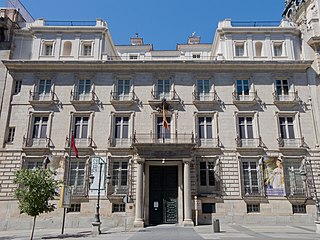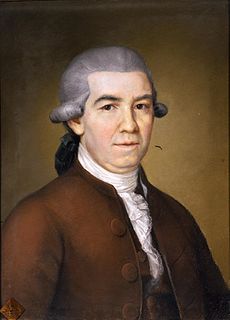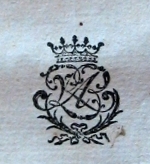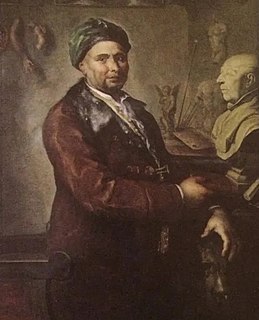

Fernando Selma (1752, Valencia - 8 January 1810, Madrid) was a Spanish engraver and illustrator.


Fernando Selma (1752, Valencia - 8 January 1810, Madrid) was a Spanish engraver and illustrator.
He began his artistic studies with Ignacio Vergara at the Real Academia de Bellas Artes de San Carlos de Valencia. In 1768, he was granted a pension by King Charles IV to continue his studies at the Real Academia de Bellas Artes de San Fernando, where he attended the drawing classes of Francisco Bayeu and learned engraving from Manuel Salvador Carmona. Only one year later, he was awarded prizes from the Academia in both categories. He was named an Academician of Merit by the Academia of Valencia in 1780, and the Academia in Madrid in 1783.
His father-in-law, Jerónimo Antonio Gil , founder of the Academy of San Carlos in Mexico City, appointed him to be in charge of the engraving classes at that institution but, in 1786, just before his departure, he chose to remain in Madrid to attend to various projects at the Royal Printing Office. [1]
As an expert in chalcography and intaglio, he participated in several ambitious editorial projects; notably the edition of Don Quixote , published by Joaquín Ibarra in 1780, under the patronage of the Royal Spanish Academy. He provided seven illustrations, the frontispiece for Part I, and some of the chapter and paragraph headings, after drawings by José del Castillo and Antonio Carnicero, among others. He also did illustrations for The Conspiracy of Catiline by Sallust (Ibarra, 1772).
For the Portraits of Illustrious Spaniards he provided the portraits of Lope de Vega (after a drawing by Rafael Ximeno y Planes), Miguel de Cervantes and Diego de Saavedra Fajardo. He also worked on the History of the Conquest of Mexico by Antonio de Solís, in the deluxe two volume edition published by Antonio de Sancha (1783-1784); providing the portrait of Hernán Cortés, from a drawing attributed to Titian. After 1786, he contributed to the Maritime Atlas of Spain. This resulted in his being criticized for abandoning historical works in favor of technical ones, to which he replied that he would rather provide images of practical use than ones to "delight the frivolous". [2]
On behalf of the "Company for the Engraving of the King's Paintings", established in 1789, he reproduced works by Anthony van Dyck, Bartolomé Esteban Murillo and Guido Reni, among others. In 1799, he was named the Court Engraver by King Charles. [2]

Rafael Ximeno y Planes was a Spanish painter and draughtsman born in Valencia and deceased in Mexico. He was the son of a silversmith and first learned the painter's profession from his maternal uncle Luis Planes. Later he studied at the Real Academia de San Fernando in Madrid thanks to a scholarship. He also studied in Rome in 1783. In 1786 he was appointed vice-director of the Real Academia de San Carlos of Valencia, and in 1793 he moved to Mexico City as the vice-director of the School of Fine Arts.

José del Castillo was a Spanish painter and engraver in the Neoclassical style. Many of his paintings were done for tapestries.

Francesco Ribalta , also known as Francisco Ribaltá or de Ribalta, was a Spanish painter of the Baroque period, mostly of religious subjects.

The Real Academia de Bellas Artes de San Fernando, located on the Calle de Alcalá in the heart of Madrid, currently functions as a museum and gallery. A public law corporation, it is integrated together with other Spanish royal academies in the Instituto de España.

Antonio Carnicero (1748–1814) was a Spanish painter of the Neoclassical style. In addition to his paintings, over the course of his career he also produced prints and engravings as well as creating theatrical decorations.

Manuel Salvador Carmona was a Spanish engraver, designer and illustrator. Two of his brothers were also artists: José Salvador Carmona, a sculptor, and Juan Antonio Salvador Carmona, also an engraver.

José Camarón Bonanat, or Bononat was a Spanish draftsman, painter and engraver. Most early sources give his maternal family name as Boronat.

Antonio Ponz was a Spanish painter.

The Academy of San Carlos is located at 22 Academia Street in just northeast of the main plaza of Mexico City. It was the first major art academy and the first art museum in the Americas. It was founded in 1781 as the School of Engraving and moved to the Academia Street location about 10 years later. It emphasized classical European training until the early 20th century, when it shifted to a more modern perspective. At this time, it also integrated with the National Autonomous University of Mexico, eventually becoming the Faculty of Arts and Design, which is based in Xochimilco. Currently, only graduate courses of the modern school are given in the original academy building.

Joaquín Ibarra y Marín, also known as Joaquín Ibarra, was a Spanish printer who was known for several important technical developments in the fields of the press, books, and typography. Some of his most important works are Conhuración de Catilina y la guerra de Yugurta, printed in 1772, and an edition of Don Quijote de la Mancha, as well as Real Academia Española, done in 1780.

José Joaquín Fabregat was an engraver and cartoonist of the New Spain who was born in Torreblanca, in the province of Castelló, and began his studies in the Academy of San Carlos.

Manuel Rodríguez de la Parra Castellano was a Spanish costumbrista painter and engraver in the Romantic style, known especially for his bullfight scenes. He was also a noted art collector.

José María Avrial y Flores was a Spanish painter, illustrator and scenographer.

Felipe de Castro was a Spanish sculptor of Galician origin. He was among the first to introduce the Neoclassical style to Spain, and served as sculptor to King Ferdinand VI. Some sources give his year of birth as 1704.

Rafael Esteve Vilella was a Spanish engraver in the Romantic style.

Juan Antonio Salvador Carmona was a Spanish engraver. His older brother, Manuel Salvador Carmona, was also an engraver and his eldest brother, José Salvador Carmona, was a sculptor.

Juan Bernabé Palomino y Fernández de la Vega was a Spanish engraver.

José Gómez de Navia was a Spanish engraver and draftsman.

Luis Fernández Noseret was a Spanish engraver who studied with Manuel Salvador Carmona at the Real Academia de Bellas Artes de San Fernando.
Pieter Perret was a Flemish engraver who worked in Madrid in the service of Philip II of Spain.
![]() Media related to Fernando Selma at Wikimedia Commons
Media related to Fernando Selma at Wikimedia Commons